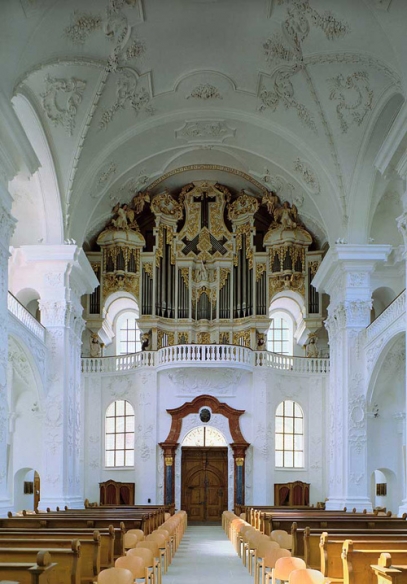

Luzern, ehem. Zisterzienserklosterkirche St. Urban, Hauptorgel

Josef Bossart 1716-1721
Bossart's organ is a very interesting example of apparently old fashioned elements like keyboards with split upper keys (as a consequence of unequal temperament) and a modern, even "gallant" sound design with a multitude of character stops in all divisions, and a beginning tendecy of dynamic graduation from main to upper to chest organ. Obviously the importance of the Plenum already waned towards a wealth of combinations of single stops. The multitude of 8’ und 4’ stops is meant to be a rich palette of colours on different volume levels. The impressive number of 40 stops hides the true quality of this organ best used in combining small numbers of stops in ever changing ways.
Some features show the long development of the Alpine type of baroque organ. So the typical stop „Hörnlein“ still exists but not as a compound stop but a single rank of thirds to be combined with a 2' rank to give the traditional sound effect, but also offering the possibility to be used for combinations „en tierce“ in French style.
The case is another example of the southern type encircling the church windows, here culminating in the unique symbol of the crucifixion displayed by (mute) organ pipes and linking the sound of the organ with Easter theology.
Music sample
Georg Friedrich Händel (1685-1759): Voluntary II in C
played by Albert Bolliger
Specification:
III+P/4; manual C-c3 with split keys for d#/e flat0/1/2, pedal C- a0 (short octaves).
HW:
Principal 8’
Viol de
Gamb 8’
Schwäglen 8’
Nachthorn 8’
Spitzfleüthen 8’
Copell 8’
Cornet 8’ 5f.
Octav 4’
Waldfleüthen 4’
Quintfleüthen 2 2 /3 ’
Superoctav 2’
Flaschroneth-Fleüthl.
2’
Quint 1 1/3 ’
Sesquialtera 1 1/3 ’ 3f.
Hörnlein 1 3/ 5 ’
Mixtur
major 1’ 4f.
Mixtur
minor 1’ 3f.
Cymbel ½’ 3f.
Fagott 8’
OW:
Echo ins Gesicht 8’
Schwäbende Fleuth. 8’
Hohl-Fleüthen 4’
Copell 4’
Superfleüthlein 2’
Mixtur 1’ 3f.
Cymbel 2/3 ’ 2f
Fagott in
Octav 4’
BW:
Secund
Principal 8’
Hohl-Fleüthen 4’
Flaschroneth-Fleüthl. 2’
Mixtur 1’ 3f.
Cymbel ½’ 2f.
P:
Subbass 16’
Portun 16’
Principal 8’
Octava und
Quinta
4’
Superoctava 2’
Mixtur 1 1/3 ’ 3f.
Viol-Bass 16’
Posaunen 8’
Couplers OW/HW, HW/P
© Greifenberger Institut für Musikinstrumentenkunde | info@greifenberger-institut.de



